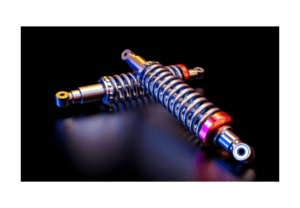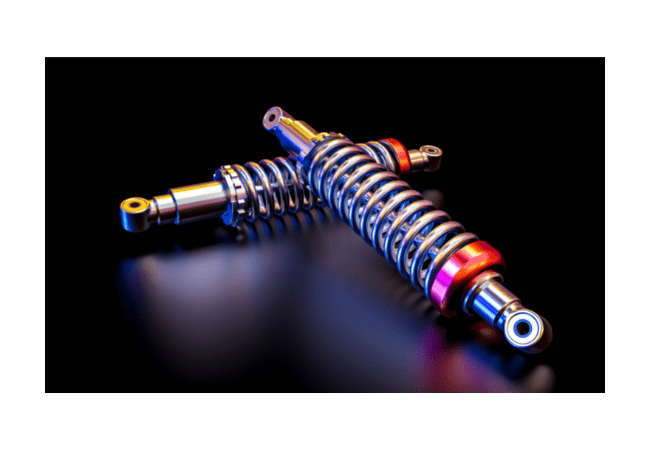Coilover shocks are a type of suspension system used in vehicles to provide a smoother ride and better handling. The term “coilover” refers to the combination of a coil spring and shock absorber in one unit. The coil spring provides the necessary spring rate to support the weight of the vehicle, while the shock absorber controls the motion of the spring and dampens the vibration from the road surface. The coil springs and shock absorbers are designed to work together to provide optimal performance. Discover what are coilover shocks and the different types of setups.
Coilover shocks have been around for several decades and have been used in various types of vehicles, including sports cars, race cars, and even off-road vehicles. The first coil over shock was invented in the 1950s by Frank Aldana, who was a race car driver and engineer. Aldana designed the adjustable coilovers shock to improve the handling and suspension of his race car, and it quickly became a popular choice among other racers.
In the 1960s, the coilover suspension became more widely used in street vehicles, as automakers began to experiment with more advanced suspension systems. The coilover shock was seen as a more efficient and compact alternative to traditional shock and spring setups. In the 1970s and 1980s, aftermarket companies began producing coilover shocks for a wider range of vehicles, and they became a popular choice among performance enthusiasts. Today, coilover suspensions are still widely used in both racing and street applications and continue to evolve with advances in suspension technology.
Jump to
Parts of Coilover Shocks

Coilover shocks are made up of several key components that work together to provide optimal suspension performance. These components include the coil spring, shock absorber, and mounting components. Each component plays a crucial role in the overall functionality of the coilover suspension.
Coil Springs
The coil spring is a helical spring that is designed to support the weight of the vehicle and provide the necessary spring rate for the suspension. Coil springs are made from a variety of materials, including steel, titanium, and composite materials. The spring rate is determined by the number of coils, wire thickness, and the diameter of the spring. The coil spring is attached to the shock absorber via the spring perch and spring preload adjuster.
Shock Absorbers
The shock absorber, also known as a damper, is responsible for controlling the motion of the coil spring and dampening the vibration from the road surface. The shock absorbers are made up of several components, including the piston, cylinder, and hydraulic fluid. The shock absorber works by compressing and rebounding as the suspension moves up and down. The compression and rebound speed can be adjusted to fine-tune the suspension setup for specific driving conditions or preferences.
Mounting Components
The mounting components include the spring perch, preload adjuster, and upper and lower mounting brackets. The spring perch is used to secure the coil spring to the shock absorber, while the preload adjuster is used to adjust the tension on the coil spring. The upper and lower mounting brackets are used to attach the coilover shock to the vehicle’s chassis and suspension components. The mounting components are designed to be strong and durable to withstand the stresses and forces of the suspension system.
Advantages of Coilover Shocks
Adjustable Height
One of the most significant advantages of adjustable coilovers is their ride height adjustment. The coil springs perch can be adjusted up or down on the shock absorber to raise or lower the vehicle’s ride height. This feature is especially beneficial for performance enthusiasts who want to fine-tune the suspension setup to match their driving style or specific driving conditions. Additionally, the adjustable height feature allows for easier installation of aftermarket wheels and tires of different sizes.
Improved Handling
Coilover shocks provide improved handling performance over traditional shock and spring setups. The coil springs and shock absorbers work together to provide better control of the suspension movement and reduce body roll. This results in better stability and cornering performance, which is especially beneficial for high-performance driving applications.
Enhanced Ride Comfort
Coilover shocks can provide a smoother ride compared to traditional shock and spring setups. The coil spring and shock absorber work together to dampen the vibration from the road surface and reduce the impact of bumps and potholes. This results in a more comfortable ride, especially on rough or uneven road surfaces.
Increased Durability
Coilover shocks are generally more durable than traditional shock and spring setups. The mounting components are typically made from high-strength materials and designed to withstand the stresses and forces of the suspension system. Additionally, the coilover shock design is more compact and efficient, which reduces the wear and tear on the components over time. This results in a longer lifespan and reduced maintenance requirements for the suspension system.
Types of Coilover Shocks
Fixed Damping Coilovers
Fixed damping coilovers are the most basic type of coilover shock. They have a fixed damping rate, which means the compression and rebound speed cannot be adjusted. These types of coilovers are typically less expensive and are suitable for everyday driving applications.
Adjustable Damping Coilovers
Adjustable damping coil overs allow for compression and rebound speed adjustment, which provides more precise tuning of the suspension setup. The adjustability feature allows for customization of the damping rate to match specific driving conditions or preferences. These types of coilovers are more expensive than fixed damping coilovers but offer better handling performance and ride quality.
Remote Reservoir Coilovers
Remote reservoir coilovers have a separate reservoir for the hydraulic fluid, which allows for greater heat dissipation and more consistent performance over extended driving periods. The remote reservoir also allows for more fine-tuning of the compression and rebound speed. These types of coilovers are typically used for high-performance driving applications, such as track racing or off-roading.
Each type of coilover shock has its own unique features and benefits. The fixed damping coilovers are suitable for everyday driving, while adjustable damping coilovers offer better-handling, performance, and ride comfort. Remote reservoir coilovers are used for high-performance driving applications that require more precise suspension tuning and greater heat dissipation. The type of coilover shock chosen will depend on the driving conditions and performance requirements of the vehicle.
Related Article – Best Coilovers for WRX
Coilover Shocks Installation and Maintenance
Coilover shocks installation can be a challenging process, especially for those who are new to working on suspension systems. However, with the proper tools and instructions, the installation can be completed relatively easily. The following are the basic steps involved in installing coilover shocks:
Installation Process
- Begin by removing the existing shock absorber and coil spring from the vehicle.
- Install the coilover shock absorber into the mounting point on the vehicle.
- Adjust the height of the coilover shock absorber to match the desired ride height of the vehicle.
- Install the coil spring onto the coilover shock absorber and adjust the preload to match the desired spring rate.
- Install any necessary mounting components and reassemble the suspension system.
Maintenance Tips
Proper maintenance of coilover shocks is essential for ensuring their longevity and performance. The following are some maintenance tips for coilover shocks:
- Regularly inspect the coilover shocks for signs of wear or damage.
- Check the shock absorber oil level and condition periodically and top up or replace if necessary.
- Inspect the mounting components for signs of wear or damage and replace as needed.
- Adjust the coilover height and spring preload settings as necessary to match the driving conditions or preferences.
- Keep the coilover shocks clean and free of debris to prevent corrosion or damage to the components.
Proper installation and maintenance of coilover springs and shocks are essential for optimal performance and longevity. The installation process involves removing the existing shock absorber and coil spring, installing the coilover shock absorber and adjusting the height and preload settings, and reassembling the coilover suspension system. Maintenance tips include regularly inspecting the coilover shocks and mounting components, checking the shock absorbers oil level, and keeping the coilover shocks clean and free of debris.
Conclusion
Coilover shocks are an essential part of any performance suspension system, providing a range of benefits and features that improve vehicle handling, comfort, and durability. In this article, we have discussed the basics of coilover shocks, including their history, parts, types, installation, and maintenance.
A coilover suspension offers a range of benefits, including adjustable ride height, improved handling, enhanced ride comfort, and increased durability. They are an excellent choice for those who want to fine-tune their suspension system for optimal performance in different driving conditions.
Coilover shocks come in various types, including fixed damping, adjustable damping, and remote reservoir coilovers. Each type has advantages and disadvantages, and the choice will depend on the driver’s preferences and driving conditions.
It’s essential to note the importance of investing in quality coilover shocks. Cheaper or poorly made coilover shocks may not provide the same performance, durability, or safety level as higher-quality models. When selecting coilover shocks, it’s vital to choose reputable brands, look for reviews and ratings, and consult with a professional mechanic or suspension expert if needed.
A coilover suspension is an excellent choice for those who want to improve their vehicle’s performance, handling, and comfort. They come in various types, each with its advantages and disadvantages, and the choice will depend on the driver’s preferences and driving conditions. It’s essential to invest in a quality coilover suspension for optimal performance and safety.

My name is Tom Harris, founder of this blog. I’m a mechanical engineer with 20 years of experience in the automotive industry. I’m here to help you with your vehicle’s problems, easy fixes and share my insights and experience so that you can enjoy your rides more.

